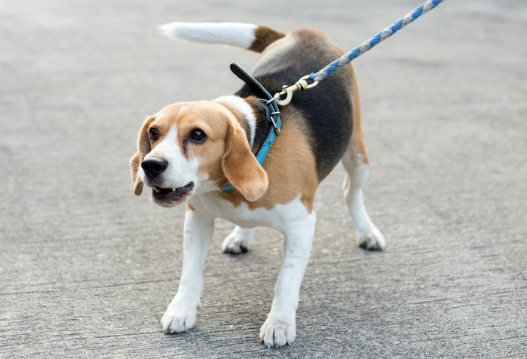In a prior post about reactivity, we went over the all-important stress zones and offered a checklist to determine if your dog is reactive. In part 2 we offer an avoidance tool and a To Do checklist to begin to help your dog.
What is a reactive dog?
To start, let’s be sure we are on the same page. Does your dog bark and lunge at every dog (or person, or car, or other trigger) in sight? Are you nervous when you take your dog for a walk? You have a reactive dog and you should know that you’re not alone. This is a common behavioral problem. What is reactivity? Why is your dog afflicted by it? Reactivity is caused by fear, stress, and anxiety. Anxiety is the anticipation that something will hurt you. It causes dogs to be hyper-vigilant, reactive, and aggressive toward things that stress them.
When your dog is being reactive it’s important to know that he is not being disobedient. Reactivity is your dog trying to defend himself. He feels trapped and vulnerable when he is on leash and approached by another dog or other stimulus. The best defense is a good offense, in the mind of your dog. It’s possible that your dog may have been traumatized by another dog, or never had a chance to be properly socialized around unfamiliar dogs. Some dogs are temperamentally shy. Genetics also plays a role.
My dog is friendly so I don’t think he’s reactive
Not all reactive dogs are fearful of other dogs. Some dogs become overly aroused and frenzied because they are so excited to see another dog. They become out of control. This emotional arousal is often coupled with frustration when the leash continually stops them. Repeated frustration can ramp up into uncontrolled emotions and result in reactivity. If this sounds like your dog, begin to change the behavior now before it worsens.
How can I begin to help my dog?

Provide enrichment during your dog’s staycation. This stress vacation allows your dog to avoid stressors and begin to feel calmer. It’s a great start to your behavior modification program.
Start with a staycation
When an animal is aroused or stressed, the body produces stress hormones. Because there is a physiologic response to stress and anxiety which does not disappear when the stressor does, dogs often stay slightly aroused or reactive for a while after the incident. If the dog is exposed to repeated stressors, he will start to be more and more reactive to smaller and smaller stressors.
Try to avoid incidents as much as possible to protect your dog from overwhelming or stressful situations; anything that may elicit a reactions. When beginning this program, avoid stressors for 3 weeks. Avoiding what causes your dog to react such as other dogs, people, cars, etc. To do that, provide your dog with a staycation and walk him only during times or in locations when he is least likely to come in contact with those stressors. This may mean using the backyard to potty him. In other words, provide a stress vacation.
Get out of Dodge: Use the Emergency U-Turn exercise
This exercise is for creating distance to keep your dog below threshold (so he does not react) when your dog’s trigger appears, but it is not your primary behavior-changing tool; it is an avoidance tool.
If you know your dog will go over threshold, act quickly. Never set your dog up to fail. Instead, in a happy and excited voice (no tension!) ask your dog to move away with you, far from the arousing stimulus. A U-Turn is a great tool to have and it’s exactly as it sounds. When you both are moving forward and on cue, you both turn 180 degrees and move in the opposite direction. This becomes the turnaround game for your dog. You should avoid turning your dog by tightening the leash. That increases the tension and could cause the very behavior you are trying to avoid. He turns because he knows the game, hears the cue, and turns quickly away from any impending problems. You can teach him to turn when cued (ideal) or you can lure him with food. The important thing is that you create distance away from the trigger quickly and before your dog reacts. Some examples of cues to use to teach your dog to turn with you (practiced without distractions) include, “Let’s go” or “Turn”.
Training Tip #1
Use the U-Turn before your dog is too aroused to listen to any of your cues, or if your dog has already begun barking or lunging at another dog (or other trigger). The U-turn is a behavior that is incompatible with barking and lunging. The purpose is to get you out of a difficult situation by moving away quickly. Practice until it is second nature. The U-Turn is your secondary tool to others that you will learn to help change your dog’s behavior.

Read your dog’s body language to proactively keep your dog from a reaction.
Training Tip #2
Learn your dog’s body language so you will recognize the signs that indicate a potential escalation of behavior and a reaction. It’s important to be prepared and respond quickly, so no walking your reactive dog while engrossed in your phone!
Training Tools
It’s important to have complete control over your dog. Being dragged down the street is no fun and is of no use to either of you. The following are recommended for this program:
- A control harness such as a Balance or Freedom harness, or a head halter such as a Gentle Leader or Halti.
- A regular 6-foot nylon or leather leash. No retractable leashes!
- A clicker (or marker word such as “Yes!”) to mark your dog’s correct behavior at the moment it occurs (always followed by a treat).
- A treat pouch with a quick open and close design.
- Lots of great rewards. It’s up to your dog to decide what she is willing to work for. Don’t give up. Try many and don’t avoid real food such as chicken and cheese. Your dog should want it when there are some distractions, not just in the house.
Pay your dog well
Awesome food, or toys if your dog is play-happy, are essential to success. The other dogs (or other triggers) are pretty intense competition for your dog’s attention, so you want to be armed with something of very high value to your dog. You don’t want to be working with your dog only armed with some dry kibble or uninteresting treats. You want your dog to love the treats you will use so find out what your dog really wants. You may think your dog is not food motivated but what this usually means is that you haven’t found what your dog will go crazy for. You can use low-value (to your dog) treats in your house, but when faced with other dogs or stressors it needs to be something that will get your dog’s attention no matter what.
Which would you prefer, a dry piece of bread or a yummy, hot slice of pizza? Test your dog’s preferences and find his equivalent of a powerfully yummy food. Try all kinds of real meat, cheese, hot dogs, or stinky treats. Stay with things that are low fat such as white meat chicken, part-skim mozzarella, or low-fat steak so as not to cause gastrointestinal upset. Freshly cooked liver is also powerful. Adjust the amount of kibble you feed for meals so that he does not gain weight. Some dogs would rather be paid with a toy. If that is the case, save that toy for training sessions only.
Here is Your To-Do List Summary
- Find your dog’s favorite rewards. Experiment with all kinds of treats/food/toys to see what your dog loves.
- Provide a staycation. Do not expose your dog to the things that cause him or her to react for 3 weeks. Allow those stress hormones to dissipate and your dog will begin to exhibit calmer behavior.
- Teach the Emergency U-turn to quickly provide distance from stimuli and avoid reactions.
- Purchase and use the right training tools.
To start, walk your dog in locations or during times where you are unlikely to come in contact with his or her triggers.
Additional Tips
- Reward your dog for calm behavior. Interact with him when he is calm, not when he is jumping around or whining/barking. Find moments of calm throughout the day to reward.
- No punishment, including hitting, yelling, choke collars, pinch collars, or shock collars. This just increases the anxiety and stress.
- Name Recognition (practice this if your dog doesn’t turn towards you when you say his name). Say your dog’s name. When he turns toward you mark it (with a click or a marker word) and treat. Repeat often.
- Keep track of your dog’s progress in a training journal.
- Unprompted Attention: When your dog chooses to look at you without you having to ask for it, reward him. Do this in the house to start and then just outside on walks. You are teaching your dog that paying attention to you is valuable. We want him to pay more attention to you and less to his environment.
- Walk your reactive dog alone. You can’t concentrate on helping your dog if you are juggling more than one dog on the walk.
- Train your dog for at least 5-10 minutes, 3 times a day. Consider each walk, a training session, plus others in the home.
I want more tools. What’s next?
The Emergency U-turn exercise is an avoidance tool to keep your dog’s stress level lower by removing or distancing him or her from the stimulus, however it will not be that effective at changing the underlying emotional issue that causes your dog to react. Do you want to continue helping your dog change his behavior from worried and reactive to calm? We have the answers! Register for our course, Your Reactive Dog: From Anxious to Zensational for game-changing results.

